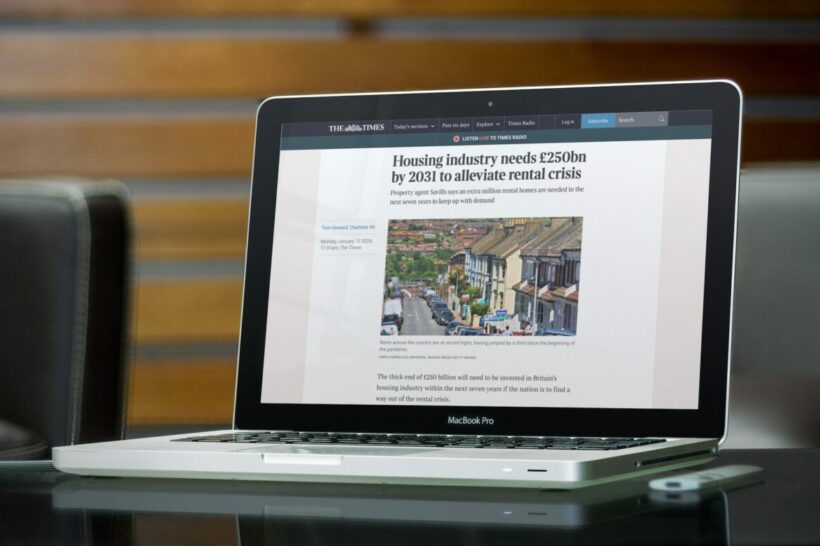16 January 2024
Housing industry needs £250bn by 2031 to alleviate rental crisis

Jon Ivory, Chief Investment Officer at Packaged Living has been quoted in The Times, speaking out about the current rental crisis in the UK. A £250 billion investment is vital to Britain’s housing industry if we are to stand a chance at delivering the additional one million rental homes, most of which need to be single-family, by 2031.
Property agent Savills says an extra million rental homes are needed in the next seven years to keep up with demand
The thick end of £250 billion will need to be invested in Britain’s housing industry within the next seven years if the nation is to find a way out of the rental crisis.
That is the view of a report from Savills, the property agent, which says an additional one million rental homes are needed between now and 2031 to keep up with demand.
Most of those will need to be “single-family homes” rather than the swanky blocks of rental apartments that have popped up in the big cities in recent years.
Proposals to fix the broader housing crisis focus on increasing the number of homes built for sale, but rentals will also play a part.
“We need to adopt a positive response to the housing crisis, across all tenures,” Jacqui Daly, director of residential research at Savills, said. “Build-to-rent can help to deliver many more homes, more quickly, and secure investment that improves the energy efficiency of the private rented sector, while meeting the needs of young, middle-income households.”
So far, £3.5 billion has been spent building just over 10,000 homes specifically made to be let out; to build another million would cost £250 billion, Savills estimates.
That kind of development is almost certainly unachievable, especially within seven years. Savills reckons there is about £60 billion waiting to be deployed into the UK build-to-rent sector, mostly into houses rather than flats.
Jonathon Ivory, chief investment officer at Packaged Living, the developer, urged investors and builders to “step up and play a societal role in delivering the one million additional rental homes” Savills thought were needed.
The anticipated shortfall in funding highlights the scale of investment required if the supply of rental homes is to eventually match demand.
Last year, rents increased by 9.7 per cent, according to Zoopla, the property search site. At an average of £1,201 per month, rents across the nation are at record highs, having jumped by a third since the beginning of the pandemic.
The rapid increase has been fuelled by a “chronic mismatch between supply and demand”, Zoopla said. Last autumn Rightmove, another property search site, estimated that there were 41 per cent more tenants looking to move then than there were in 2019. At the same time, the number of available rental homes had fallen by 35 per cent.
There has been talk of a “landlord exodus”, although the data suggests buy-to-let owners have, broadly, stopped adding to their portfolios. The number of rental homes in the UK doubled between 2002 and 2015 to 5.4 million and it has stayed around that level, despite the population growing and record levels of immigration.
The slowdown probably reflects changes to tax breaks announced by George Osborne when he was the chancellor in 2015 and introduced two years later.
The supply-demand imbalance has been particularly acute of late, with many would-be buyers staying put in their rentals while they wait for mortgage rates to retreat.
David Reid, managing director of suburban build-to-rent at Legal & General, said “committed and collaborative action from government, businesses and investors” was needed to increase the supply of rental housing in the UK.
He said: “Now more than ever, we must deliver diverse residential offerings to better accommodate the broad range of different households that exist in the market.”
Separately, a record number of buy-to-let companies were set up last year despite a wider decline in landlord purchases, research has found.
Across the UK a total of 50,004 limited companies were set up to hold buy-to-let properties, surpassing the previous year’s record 48,540.
The number of such companies has increased markedly since Osborne introduced legislation which meant landlords could no longer deduct any of their mortgage interest from their rental income when calculating taxable profits.
Landlords instead receive 20 per cent tax relief on mortgage interest payments, making it more profitable to hold a buy-to-let property through a limited company which can offset all their mortgage interest.
At the beginning of this year 345,426 limited companies owned 615,077 properties across England and Wales, with 24 per cent of all UK properties held in any sort of limited company structure.
Aneisha Beveridge, head of research at Hamptons, the property agent, said: “Despite last year’s slowing sales market, there was no let-up in landlords rushing to incorporate. Rather, the record number of companies set up to hold buy-to-let homes suggests a long-term commitment from landlords, particularly given the upfront costs associated with incorporating.
“The growth has been driven mostly by existing landlords moving properties into a corporate structure to shelter themselves from higher interest rates. Meanwhile, the number of new landlords setting up shop has remained relatively muted.”


